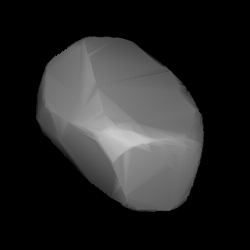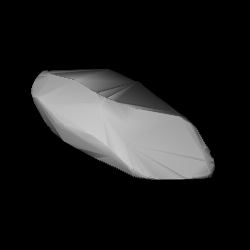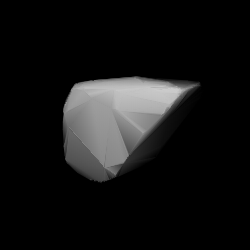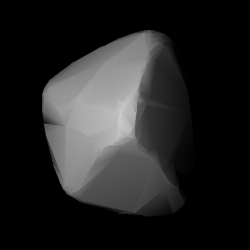Related Research Articles
2098 Zyskin, provisional designation 1972 QE, is a vestoid asteroid from the inner regions of the asteroid belt, approximately 10 kilometers in diameter. It was discovered by Russian–Ukrainian astronomer Lyudmila Zhuravleva at the Crimean Astrophysical Observatory in Nauchnyj on 18 August 1972. The asteroid was named for surgeon Lev Zyskin (1930–1994).

1858 Lobachevskij is a rare-type background asteroid from the central region of the asteroid belt, approximately 13 kilometers in diameter. It was discovered on 18 August 1972, by Soviet astronomer Lyudmila Zhuravleva at the Crimean Astrophysical Observatory in Nauchnyj, on the Crimean peninsula. The asteroid was named after Russian mathematician Nikolai Lobachevsky.
1909 Alekhin, provisional designation 1972 RW2, is a stony asteroid and slow rotator from the inner regions of the asteroid belt, approximately 17 kilometers in diameter. It was discovered on 4 September 1972, by Russian–Ukrainian astronomer Lyudmila Zhuravleva at the Crimean Astrophysical Observatory, Nauchnyj, on the Crimean peninsula, and named after chess grandmaster and World Chess Champion Alexander Alekhine.
1910 Mikhailov, provisional designation 1972 TZ1, is a carbonaceous asteroid from the outer regions of the asteroid belt, approximately 35 kilometers (22 mi) in diameter. Discovered at Nauchnyj in 1972, it was named after Russian astronomer Aleksandr Aleksandrovich Mikhailov. It has a 3:1 ratio of iron to carbon, hence the name. The asteroid is believed to have been expelled from its parent asteroid belt (one of three main asteroid belts in the inner Solar System), and is classified as a metallic asteroid, because its iron is fairly weak.
3067 Akhmatova, provisional designation 1982 TE2, is a stony Flora asteroid from the inner regions of the asteroid belt, approximately 6 kilometers in diameter.
3724 Annenskij, provisional designation 1979 YN8, is a stony Gefionian asteroid from the central regions of the asteroid belt, approximately 14 kilometers (9 miles) in diameter. It was discovered on 23 December 1979, by Soviet astronomer Lyudmila Zhuravleva at the Crimean Astrophysical Observatory in Nauchnij, on the Crimean peninsula. The S-type asteroid has a rotation period of 3.97 hours. It was named for Russian poet Innokenty Annensky.
4936 Butakov, provisional designation 1985 UY4, is a stony Florian asteroid from the inner regions of the asteroid belt, approximately 5 kilometers in diameter. The asteroid was discovered on 22 October 1985, by Soviet–Ukrainian astronomer Lyudmila Zhuravleva at the Crimean Astrophysical Observatory in Nauchnyj, on the Crimean peninsula. It was named after Russian admiral Grigory Butakov.

1900 Katyusha is a stony background asteroid from the inner asteroid belt, approximately 9 kilometers in diameter. It was discovered on 16 December 1971, by Russian astronomer Tamara Smirnova at the Crimean Astrophysical Observatory in Nauchnyj, on the Crimean peninsula and named in honor of Yekaterina Zelenko, the only woman to credited with conducting an aerial ramming.
2140 Kemerovo, provisional designation 1970 PE, is a dark asteroid from the outer region of the asteroid belt, approximately 30 kilometers in diameter.
2008 Konstitutsiya, provisionally designated 1973 SV4, is a carbonaceous asteroid from the outer region of the asteroid belt, approximately 50 kilometers in diameter. It was discovered on 27 September 1973, by Soviet astronomer Lyudmila Chernykh at the Crimean Astrophysical Observatory in Nauchnyj, on the Crimean peninsula. The asteroid was named for the 1977 Soviet Constitution.

2094 Magnitka (prov. designation: 1971 TC2) is a Flora asteroid from the inner regions of the asteroid belt, approximately 12 kilometers (7.5 miles) in diameter. It was discovered on 12 October 1971, at and by the Crimean Astrophysical Observatory in Nauchnyj, on the Crimean peninsula. The discovery has not been attributed to an observing astronomer. It was later named for the city of Magnitogorsk.
1771 Makover, provisional designation 1968 BD, is a carbonaceous asteroid from the outer region of the asteroid belt, approximately 50 kilometers in diameter.
1857 Parchomenko, provisional designation 1971 QS1, is a stony asteroid and suspected binary from the inner regions of the asteroid belt, approximately 8 kilometers in diameter.
2122 Pyatiletka, provisional designation 1971 XB, is a stony asteroid from the inner regions of the asteroid belt, approximately 11 kilometers in diameter.
1907 Rudneva, provisional designation 1972 RC2, is a stony background asteroid from the central regions of the asteroid belt, approximately 11 kilometers in diameter. It was discovered on 11 September 1972, by astronomer Nikolai Chernykh at the Crimean Astrophysical Observatory, Nauchnyj, on the Crimean peninsula. The asteroid was named after Soviet geodesist and war hero Yevgeniya Rudneva.
1737 Severny, provisional designation 1966 TJ, is a stony Eoan asteroid from the outer region of the asteroid belt, approximately 21 kilometers in diameter.

1854 Skvortsov (prov. designation: 1968 UE1) is a stony background asteroid and relatively slow rotator from the middle region of the asteroid belt, approximately 9 kilometers in diameter. It was discovered on 22 October 1968, by Russian astronomer Tamara Smirnova at the Crimean Astrophysical Observatory in Nauchnyj on the Crimean peninsula. It is named after astronomer Evgenii Skvortsov.

2120 Tyumenia is a dark background asteroid, approximately 45 kilometers in diameter, located in the outer regions of the asteroid belt. It was discovered on 9 September 1967, by Soviet astronomer Tamara Smirnova at the Crimean Astrophysical Observatory in Nauchnyj, on the Crimean peninsula. The asteroid was named for the now Russian district of Tyumen Oblast in Western Siberia.
1790 Volkov, provisional designation 1967 ER, is a stony Florian asteroid from the inner regions of the asteroid belt, approximately 8 kilometers in diameter.
23436 Alekfursenko (provisional designation 1982 UF8) is a carbonaceous Hygiean asteroid from the outer region of the asteroid belt, approximately 8.4 kilometers (5.2 miles) in diameter. It was discovered on 21 October 1982, by Russian–Ukrainian astronomer Lyudmila Zhuravleva at the Crimean Astrophysical Observatory, Nauchnyj, on the Crimean peninsula. The likely C-type asteroid has a rotation period of 3.6 hours. It was named after Russian historian Aleksandr Fursenko.
References
- 1 2 3 4 "JPL Small-Body Database Browser: 1859 Kovalevskaya (1972 RS2)" (2017-02-15 last obs.). Jet Propulsion Laboratory. Archived from the original on 18 September 2020. Retrieved 9 June 2017.
- 1 2 3 Schmadel, Lutz D. (2007). "(1859) Kovalevskaya". Dictionary of Minor Planet Names – (1859) Kovalevskaya. Springer Berlin Heidelberg. p. 149. doi:10.1007/978-3-540-29925-7_1860. ISBN 978-3-540-00238-3.
- 1 2 3 4 5 6 7 "LCDB Data for (1859) Kovalevskaya". Asteroid Lightcurve Database (LCDB). Retrieved 20 April 2016.
- 1 2 3 Masiero, Joseph R.; Grav, T.; Mainzer, A. K.; Nugent, C. R.; Bauer, J. M.; Stevenson, R.; et al. (August 2014). "Main-belt Asteroids with WISE/NEOWISE: Near-infrared Albedos". The Astrophysical Journal. 791 (2): 11. arXiv: 1406.6645 . Bibcode:2014ApJ...791..121M. doi:10.1088/0004-637X/791/2/121 . Retrieved 8 December 2016.
- 1 2 3 Tedesco, E. F.; Noah, P. V.; Noah, M.; Price, S. D. (October 2004). "IRAS Minor Planet Survey V6.0". NASA Planetary Data System – IRAS-A-FPA-3-RDR-IMPS-V6.0. 12. Bibcode:2004PDSS...12.....T . Retrieved 17 October 2019.
- 1 2 3 4 Mainzer, A.; Grav, T.; Masiero, J.; Hand, E.; Bauer, J.; Tholen, D.; et al. (November 2011). "NEOWISE Studies of Spectrophotometrically Classified Asteroids: Preliminary Results". The Astrophysical Journal. 741 (2): 25. arXiv: 1109.6407 . Bibcode:2011ApJ...741...90M. doi:10.1088/0004-637X/741/2/90 . Retrieved 18 May 2016.
- 1 2 3 Waszczak, Adam; Chang, Chan-Kao; Ofek, Eran O.; Laher, Russ; Masci, Frank; Levitan, David; et al. (September 2015). "Asteroid Light Curves from the Palomar Transient Factory Survey: Rotation Periods and Phase Functions from Sparse Photometry". The Astronomical Journal. 150 (3): 35. arXiv: 1504.04041 . Bibcode:2015AJ....150...75W. doi:10.1088/0004-6256/150/3/75 . Retrieved 20 April 2016.
- 1 2 "1859 Kovalevskaya (1972 RS2)". Minor Planet Center. Retrieved 20 April 2016.
- ↑ Schmadel, Lutz D. (2009). "Appendix – Publication Dates of the MPCs". Dictionary of Minor Planet Names – Addendum to Fifth Edition (2006–2008) . Springer Berlin Heidelberg. p. 221. Bibcode:2009dmpn.book.....S. doi:10.1007/978-3-642-01965-4. ISBN 978-3-642-01964-7.
- ↑ "Minor Planet Discoverers (by number)". Minor Planet Center. 23 March 2016. Retrieved 20 April 2016.